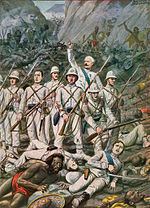~420 killed~80 wounded unknown Result Ethiopian victory | Dates 26 Jan 1887 – 24 Jan 1887 | |
 | ||
Similar Battle of Adwa, First Italo‑Ethiopian War, Battle of Amba Alagi, Battle of Gallabat, Second Italo‑Ethiopian War | ||
Battle of dogali
The Battle of Dogali was fought on 26 January 1887 between Italy and Ethiopia in Dogali near Massawa, in present-day Eritrea.
Contents
Battle of dogali
History
The Italians (after their unification in 1861) wanted to create their own colonies in Africa and started to occupy coastal Eritrea. Soon they were at war with the Ethiopians in 1885.
On his own initiative, Ras Alula Engida, then governor under Emperor Yohannes IV, attacked the Italian-controlled town of Sahati on the day prior. Hundreds of his men were slaughtered by cannon and rifle fire, while only four Italians were injured, forcing Ras Alula to pull his men back.
The besieged Italians needed ammunitions and requested supplies.
On January 26, a battalion of 500 men (mostly Italians and a few Eritrean Askari) under Colonel Tommaso De Cristofori, sent to reinforce the Italian garrison at Sahati, were attacked while in march by Ras Alula's men at Dogali. Although the 500 Italians fought back bravely against 7,000 Ethiopians, holding out for hours until they exhausted all ammunition, nearly all were then killed, except for eighty wounded men who were able to escape unoticed by the Ethiopians and be successfully rescued.
Although a small victory for the Ethiopians, Haggai Erlich notes that this incident only encouraged the Italians to intrigue with Yohannes' rival, Menelik II, then ruler only of Shewa, and encourage his insubordination towards his Emperor.
Italians felt that the battle of Dogali was an insult to be avenged, and then started to attack Ethiopia in the following years in order to get revenge. This would later lead to the First Italo-Ethiopian War which ended in their defeat at Adwa. In 1936, they finally obtained their revenge with the Second Italo-Ethiopian War with a brief occupation only to be defeated by a joint British and Ethiopian liberation force.
Actual Ethiopian celebrations
This battle was celebrated under the Derg regime, and Mengistu Haile Mariam commemorated the centennial with much attention, including the erection of a monument topped with a red star on the battlefield. Following Eritrean independence, the monument was removed. Paul B. Henze diplomatically notes in a footnote, "When I crossed the battlefield in 1996, I could detect no trace of the monument."
Erlich provides more information: when Eritrean troops gained control of the area in 1989, "a prominent commander of the Eritrean People's Liberation Front, and a former Minister of Foreign Affairs, Petros Solomon himself was delighted to blast Mengistu's monument of Ras Alula."
This could be attributed to the fact that while Alula was an administrator appointed by Yohannes IV over small parts of the Eritrean highlands, he committed many atrocities against the local Biher-Tigrinya population, sowing seeds of discord. Observers, including Erlich and others, attribute this to Eritrean Tigrinya views of their own relationship with Ethiopia as a whole. Since Alula fought for the Empire and not for Medri Bahri, he is viewed as a traitor on the Eritrean side of the border, a hero on the Ethiopian side.
Tributes
The huge square in Rome in front of Termini railway station is called Piazza dei Cinquecento, in honor of the 500 Italian soldiers killed in the Battle of Dogali. Near the square is also a monument to those soldiers.
The Italian cruiser Dogali was named for the engagement.
